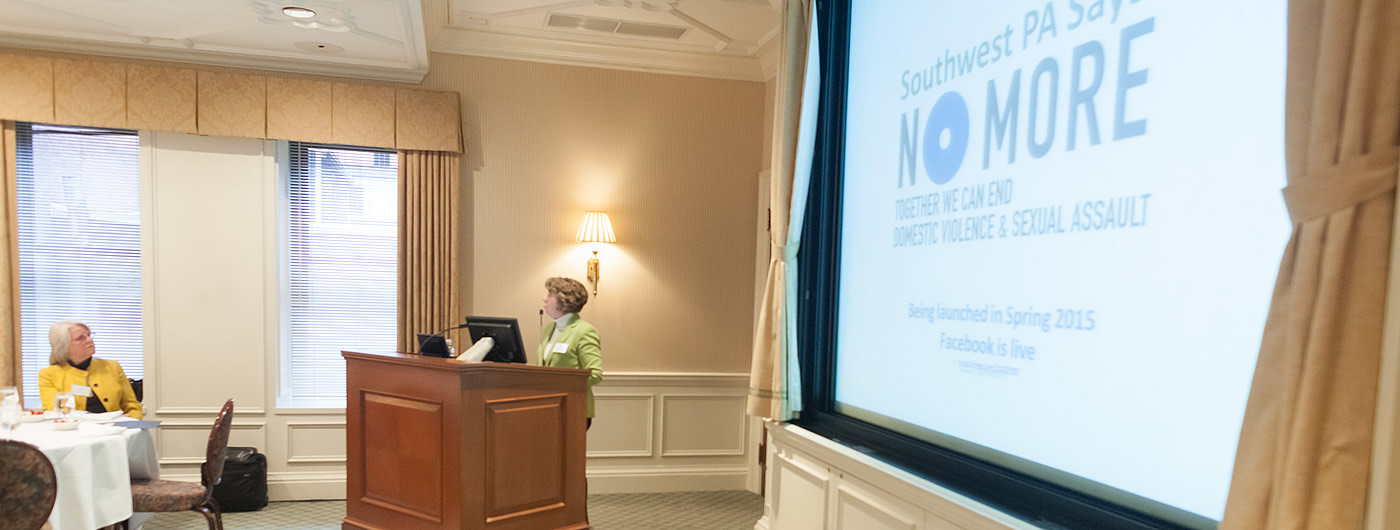More than twenty groups join forces: Together we can end domestic and sexual violence
Southwest PA Says No More will showcase local prevention efforts
Pittsburgh, PA— A diverse array of 22 organizations across the region are joining together with one focus: to end violence against women. Partners include domestic violence shelters, rape crisis programs and human service organizations like the Jewish Community Center of Greater Pittsburgh, the YMCA of Greater Pittsburgh, and Children’s Hospital of Pittsburgh. FISA Foundation, in partnership with The Heinz Endowments developed Southwest PA Says No More to showcase this work, and to make it easier for individuals and organizations to take action to stop gender-based violence.
The incidence of domestic and sexual violence point to the urgency of this issue:
- On average more than three women a day are murdered by their husbands or boyfriends in the United States.1
- Nearly one in four women in the United States reports experiencing violence by a current or former spouse or boyfriend at some point in her life.2
- Young women ages 20 to 24 are at the greatest risk of experiencing nonfatal intimate partner violence.3
We Must Do More
We cannot build enough women’s shelters to end violence against women, said Kristy Trautmann, Executive Director of the FISA Foundation: “We cannot focus only on helping girls and women reduce their risk of being raped and beaten. We must do more to prevent these crimes from happening in the first place.”
Pennsylvania has been a leader in developing domestic violence shelters and rape crisis programs, improving police response, pioneering best practices in the courts, and providing counseling and advocacy. “That work is critically important, but it’s not enough—we cannot build enough women’s shelters to end violence against women,” said Kristy Trautmann, Executive Director of the FISA Foundation: “We cannot focus only on helping girls and women reduce their risk of being raped and beaten. We must do more to prevent these crimes from happening in the first place.”
While most of these crimes are perpetrated by men, it’s a small minority of men who are abusive. Letting abusers off the hook or excusing their behavior is an insult to the many good men in our communities who respect women and believe in doing the right thing. The “boys will be boys” attitude that has excused men’s violence in the past is outdated. Across the globe and here in southwest PA, men in our community are standing up and speaking out against violence against women. Southwest PA Says NO MORE will be a way to both showcase and engage in that work.
Many innovative and effective efforts to prevent violence against women are in place across this region, including programs such as: Coaching Boys Into Men, the Father’s Day Pledge to End Domestic Violence, STANDING FIRM: The Business Case to End Partner Violence, training programs aimed at helping men get involved in this issue, school-based prevention programs and more. Southwest PA Says No More connects the dots and illustrates the movement that is building as more individuals and organizations focus on prevention.
Collaboration is Key
The Centers for Disease Control and other national experts have long recommended that to be effective, prevention efforts need to address individuals, families, communities and culture over a long period of time. No one group has the capacity to do this, but through collaboration much more becomes possible.
The website will serve as both a resource and place to take meaningful action. Any organization engaged in primary prevention is encouraged to join this initiative and add their efforts to those already highlighted. Individuals are also encouraged to join the effort and learn how to support prevention in their personal lives.There are currently 22 partners who have signed onto the effort, with more joining in weekly.
Together we can end domestic violence and sexual assault.
Contact us to learn more, get involved, become a partner or share your ideas
- Catalano, Shannan. 2007. Intimate Partner Violence in the United States. U.S. Department of Justice, Bureau of Justice Statistics. Available at http://bjs.ojp.usdoj.gov/content/pub/pdf/ipvus.pdf.
- Adverse Health Conditions and Health Risk Behaviors Associated with Intimate Partner Violence, Morbidity and Mortality Weekly Report. February 2008. Centers for Disease Control and Prevention. Available at http://www.cdc.gov/mmwr/PDF/wk/mm5705.pdf.
- Catalano, Shannan. 2007. Intimate Partner Violence in the United States. U.S. Department of Justice, Bureau of Justice Statistics. Available at http://bjs.ojp.usdoj.gov/content/pub/pdf/ipvus.pdf.

